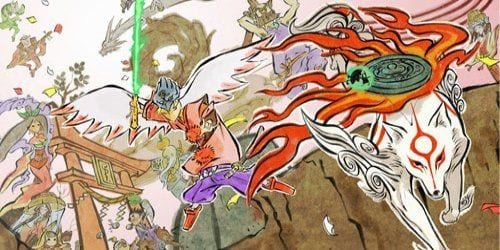
“Least Commercially Successful Winner of a Game of the Year Award.” This is Okami‘s legacy.
There’s a video game cliché that gets batted around by critics: “Mere screen shots don’t do it justice.” A statement like that is practically a tautology; unless the game deals primarily in static images à la Myst or Shadowgate, the statement is bound to be true. Still, for a game like Okami, it feels like such a statement means a little bit more. In fact, the statement could be amended to something like “mere screen shots make it look painfully ugly, but it’s really not.” Granted, that doesn’t exactly have the same ring to it — but the point remains.
Especially amidst its contemporaries, screen shots of Okami look ugly. The visual aesthetic of the entire game is paper models and brushstrokes, 2D techniques in a 3D world. The brushstrokes make for figural outlines that go from thick to thin and back again; the papercraft style of much of the environment means you see it from the same angle no matter the location from which you happen to be looking at it.
It seems hard to believe at a time when video has all but entirely taken over the internet experience, but in 2006, we still spent a lot of time looking at screen shots. Based on what we could see, all the raves and accolades in the world wouldn’t have convinced us to buy something that looked like Okami. The reviews seemed to perpetuate a disconnect. All the words in the world couldn’t convince us of something contrary to what we could see with our own eyes.
This is a shame, of course, because Okami in action is beautiful. Stunning, even.
An HD redux of Okami is, then, a good idea for two distinct reasons. For one, the mere presence of the “HD” designation in the title is something of a promise from publisher to consumer that what they’re going to be playing is actually worth looking at. Okami is by all means worth looking at, and the HD translation is expertly done. There is a sense of flow to the graphics of Okami that makes the entire game look as though a light breeze is blowing. The paper trees sway, and the belts and hair of the various characters flutter in a land that spirals, twists, and turns. Much of the flow of the original was accomplished through blur and strategic shading. With only so many pixels (not to mention only so much horsepower) to work with, the graphic artists of Clover Studios did everything in their power to infuse the game with that flow.
What the PS3 allows is a much purer vision of Okami. The brushstrokes look positively organic, and the environments, particularly in those moments where dying nature bursts its way to life, are utterly vibrant and pure. While Okami was always a beautiful game, now it is positively luscious.
The second, and perhaps more important reason that a re-release of Okami is a good idea is that it gives the game another console, another potential audience. It is a game with mostly positive word of mouth that not everybody has played. The fact that it never caught on with either the PS2 or the DS audience may actually positively affect the sales of this PS3 version. As opposed to other more action-oriented HD conversions for which a major part of the appeal is to play through a game you have already played, it’s tough to see the “already-played” audience coming out for a 40-hour Zelda-esque adventure.
Instead, for many of us, Okami is the game we never got around to. This is yet another chance to get there.
Playing it, it’s easy to see what was so revolutionary about the game at the time. Despite the obvious debt that Okami owes the Legend of Zelda games, the idea that the protagonist could in fact bend the environment with a mere brush was just fantastical enough to tickle our imaginations, yet just concrete enough to work naturally as a game mechanic. It doesn’t feel revolutionary now — revolutionary is awfully difficult when independent game development brushes up with the mainstream the way it does today — but there’s still nothing quite like it out there. We can see not only its influences, but what it has influenced. Bringing life to the world is an idea that Flower fleshed out only a few years later, and bringing drawings to life in a dynamic world is something Petri Purho brilliantly ran with in Crayon Physics Deluxe. Seeing such an obvious influence in action in the new light of HD is fascinating.
Maybe that’s the best way to describe Okami HD, honestly. It’s fascinating. It’s a joy to look at, and as an artifact of history, it’s worth studying. Its world is gorgeous, and it’s an interesting, if not often exciting, game to play through. One has the impression, though, that this PS3 version may well be its last go. It doesn’t scream for attention, and this edition probably won’t sell any better than any other version. It’s good that it’s getting one more shot. If you haven’t played Okami and games interest you in a historical sense, you’ll do well to give it a look while you still have the chance.

![Call for Papers: All Things Reconsidered [MUSIC] May-August 2024](https://www.popmatters.com/wp-content/uploads/2024/04/all-things-reconsidered-call-music-may-2024-720x380.jpg)



